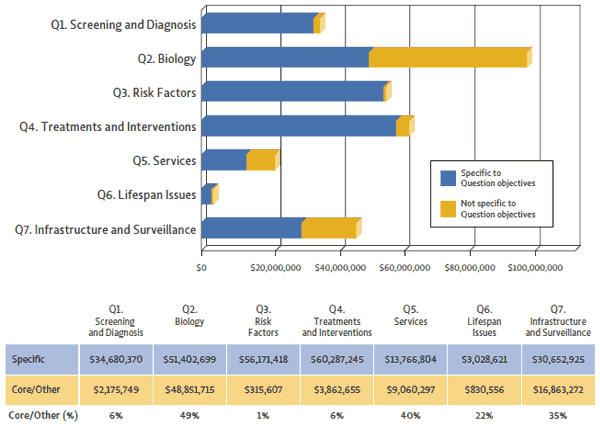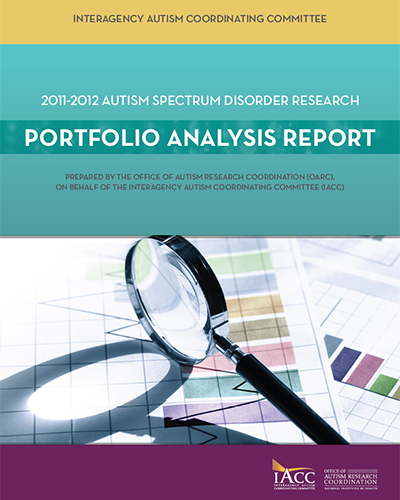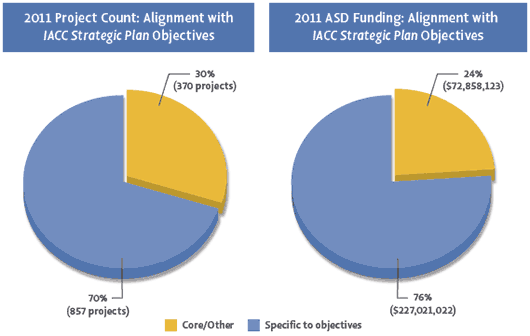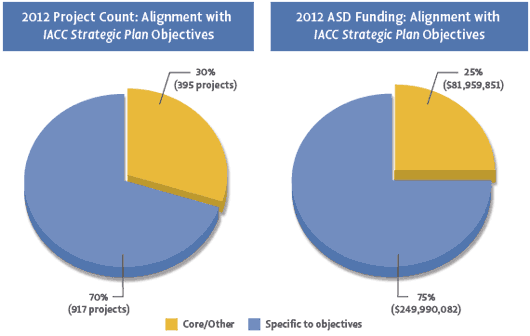Portfolio Analysis Report
IACC Autism Spectrum Disorder Research
2011 - 2012
The 78 Strategic Plan objectives were developed by the IACC to set priorities for investment, and they represent areas where the Committee perceived gaps in research that required further research efforts. Thus, areas of research that were already well-established and funded, and research fields that have emerged more recently, are not represented among the IACC Strategic Plan’s objectives. In addition to projects that represent crosscutting or well-established areas of science, some projects did not fit neatly into a Strategic Plan objective category because they lacked particular key aspects of research design required by the objective.
Efforts were made to match all 2011 and 2012 autism research-related projects with the best fitting research objective in the Strategic Plan, though in some cases, projects could only be assigned to a Strategic Plan question, and for the objective category, were assigned to Core/Other. The Core/Other category captures projects that may be related to crosscutting or “core” activities that help support the autism research field, or projects in well-established areas of science that do not fit within the list of specific research objectives outlined in the Strategic Plan. The Core/Other designation was developed by the IACC because the Committee felt it would help readers understand that even though activities in this category fall outside the specific research objectives of the Strategic Plan, they represent projects that are contributing in important ways to the progress of ASD research.
Analysis of the 2011 and 2012 project portfolios to determine the proportion of projects that fit within Strategic Plan objectives versus the proportion that did not fit within Strategic Plan objectives (Figures 14 and 15) showed that in both 2011 and 2012, every question of the Strategic Plan included projects that were not specific to a particular objective (projects coded to Core/Other). These projects represented approximately 30% of the total number of projects in both years (370 projects in 2011 and 395 projects in 2012). When looking at the proportion of funding from across all seven Strategic Plan question areas devoted to projects that were categorized as Core/Other, a similar pattern emerges, with about 25% of the funding in 2011 and 2012 devoted to these projects (Figures 12 and 13).
Figure 12. Alignment of 2011 Project Count and ASD Funding of Projects with the IACC Strategic Plan.
Figure 13. Alignment of 2012 Project Count and ASD Funding of Projects with the IACC Strategic Plan.
Of all seven questions of the Strategic Plan, Question 2 contained the largest proportion of funding that did not align with any specific objective (56% of funding in 2011 and 49% in 2012). More detail on the types of research represented by projects that were categorized as Core/Other can be found in subsequent chapters of this report that are focused on each Strategic Plan question.
2011 ASD Funding: Alignment with IACC Strategic Plan Objectives

Figure 14. Each question in the Strategic Plan contained projects that were not specific to a particular objective, designated Core/Other. Funding for projects that fall under specific objectives are indicated in blue, and Core/Other projects are indicated in orange. Subcategory analysis provided within the summary for each question of the Strategic Plan provides a description of the research areas addressed by all projects, including those assigned to Core/Other.
2012 ASD Funding: Alignment with IACC Strategic Plan Objectives

Figure 15. Each question in the Strategic Plan contained projects that were not specific to a particular objective, designated Core/Other. Funding for projects that fall under specific objectives are indicated in blue, and Core/Other projects are indicated in orange. Subcategory analysis provided within the summary for each question of the Strategic Plan provides a description of the research areas addressed by all projects, including those assigned to Core Other.






